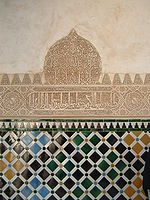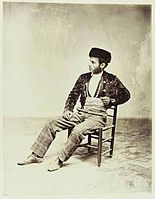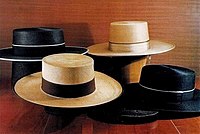Andalusia
Andalusia
Andalucía (Spanish) | |
|---|---|
|
Coat of arms | |
| Motto(s): | |
| Anthem: "La bandera blanca y verde" (English: "The White and Green flag") | |
Parliament of Spain | |
| Congress seats | 61 of 350 (17.4%) |
| Senate seats | 41 of 265 (15.5%) |
| Area (17.3% of Spain) | |
| • Total | 87,599 km2 (33,822 sq mi) |
| • Rank | |
| Official languages | Spanish |
14th) | |
| Time zone | CET (UTC+1) |
| • Summer (DST) | CEST (UTC+2) |
| ISO 3166 code | ES-AN |
| Telephone code(s) | +34 95 |
| Currency | Euro (€) |
| Official holiday | February 28 |
| Website | www |
 | |
Andalusia (
Andalusia is immediately south of the autonomous communities of
The main mountain ranges of Andalusia are the
The name Andalusia is derived from the
Andalusia has historically been an agricultural region, compared to the rest of Spain and the rest of Europe. Still, the growth of the community in the sectors of industry and services was above average in Spain and higher than many communities in the Eurozone. The region has a rich culture and a strong identity. Many cultural phenomena that are seen internationally as distinctively Spanish are largely or entirely Andalusian in origin. These include flamenco and, to a lesser extent, bullfighting and Hispano-Moorish architectural styles, both of which are also prevalent in some other regions of Spain.
Andalusia's hinterland is the hottest area of Europe, with
Name
Its present form is derived from the Arabic name for Muslim Iberia, "Al-Andalus".[22][23][24] The etymology of the name "Al-Andalus" is disputed,[25] and the extent of Iberian territory encompassed by the name has changed over the centuries.[26] Traditionally it has been assumed to be derived from the name of the Vandals. Since the 1980s, a number of proposals have challenged this contention. Halm, in 1989, derived the name from a Gothic term, *landahlauts,[27] and in 2002, Bossong suggested its derivation from a pre-Roman substrate.[25]
The Spanish place name Andalucía (immediate source of the English Andalusia) was introduced into the
Like the Arabic term al-Andalus, in historical contexts the Spanish term Andalucía or the English term Andalusia do not necessarily refer to the exact territory designated by these terms today. Initially, the term referred exclusively to territories under Muslim control. Later, it was applied to some of the last Iberian territories to be regained from the Muslims, though not always to exactly the same ones.
- As a literal translation of the Arabic al-Ándalus when Arabic texts are quoted.
- To designate the territories the Christians had regained by that time in the Guadalquivir valley and in the Kingdoms of Granada and Murcia. In a document from 1253, Alfonso X styled himself Rey de Castilla, León y de toda Andalucía ("King of Castile, León and all of Andalusia").
- To designate the territories the Christians had regained by that time in the Guadalquivir valley until that date (the Kingdoms of Jaén, Córdoba and Seville – the Kingdom of Granada was incorporated in 1492). This was the most common significance in the Late Middle Ages and Early modern period.[29]
From an administrative point of view, Granada remained separate for many years even after the completion of the Reconquista
Symbols

The Andalusian emblem shows the figure of
The official flag of Andalusia consists of three equal horizontal stripes, coloured green, white, and green respectively; the Andalusian coat of arms is superimposed on the central stripe.
The anthem of Andalusia was composed by José del Castillo Díaz (director of the Municipal Band of Seville, commonly known as Maestro Castillo) with lyrics by Blas Infante.[34] The music was inspired by Santo Dios, a popular religious song sung at harvest time by peasants and day labourers in the provinces of Málaga, Seville, and Huelva. Blas Infante brought the song to Maestro Castillo's attention; Maestro Castillo adapted and harmonized the traditional melody. The lyrics appeal to the Andalusians to mobilise and demand tierra y libertad ("land and liberty") by way of agrarian reform and a statute of autonomy within Spain.
The
The national holiday, Andalusia Day, is celebrated on 28 February,[37] commemorating the 1980 autonomy referendum.
The honorific title of Hijo Predilecto de Andalucía ("Favourite Son of Andalusia") is granted by the Autonomous Government of Andalusia to those whose exceptional merits benefited Andalusia, for work or achievements in natural, social, or political science. It is the highest distinction given by the Autonomous Community of Andalusia.[38]
Geography
The Sevillian historian Antonio Domínguez Ortiz wrote that:
one must seek the essence of Andalusia in its geographic reality on the one hand, and on the other in the awareness of its inhabitants. From the geographic point of view, the whole of the southern lands is too vast and varied to be embraced as a single unit. In reality there are not two, but three Andalusias: the
Penibética[39]
Location
Andalusia has a surface area of 87,597 square kilometres (33,821 sq mi), 17.3% of the territory of Spain. Andalusia alone is comparable in extent and in the variety of its terrain to any of several of the smaller European countries. To the east is the
.Climate
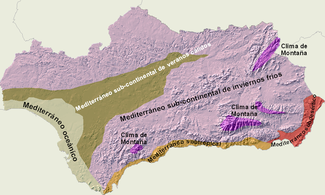
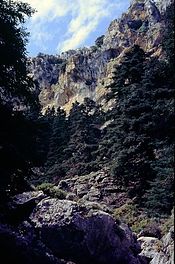
Andalusia is home to the hottest and driest climates in Spain, with yearly average rainfall around 150 millimetres (5.9 in) in
Andalusia sits at a latitude between 36° and 38° 44' N, in the warm-temperate region. In general, it experiences a
Annual rainfall in the Sierra de Grazalema has been measured as high as 4,346 millimetres (171.1 in) in 1963, the highest ever recorded for any location in Iberia.[49] Andalusia is also home to the driest place in continental Europe, the Cabo de Gata, with only 117 millimetres (4.6 in) of rain per year.
In general, as one goes from west to east, away from the Atlantic, there is less precipitation.[49] "Wet Andalusia" includes most of the highest points in the region, above all the Sierra de Grazalema but also the Serranía de Ronda in western Málaga. The valley of the Guadalquivir has moderate rainfall. The Tabernas Desert in Almería, Europe's only true desert, has less than 75 days with any measurable precipitation, and some particular places in the desert have as few as 50 such days. Much of "dry Andalusia" has more than 300 sunny days a year.[50]
The average temperature in Andalusia throughout the year is over 16 °C (61 °F). Averages in the cities range from 15.1 °C (59.2 °F) in
The Guadalquivir valley has experienced some of the highest temperatures recorded in Europe, with a maximum of 47.6 °C (117.7 °F) recorded at
| Location | Coldest month | April | Warmest month | October |
|---|---|---|---|---|
| Almería | 16.9 °C (62.4 °F)/ 8.3 °C (46.9 °F) | 24.1 °C (75.4 °F)/ 15.3 °C (59.5 °F) | 31.0 °C (87.8 °F)/ 22.4 °C (72.3 °F) | 24.5 °C (76.1 °F)/ 16.3 °C (61.3 °F) |
| Cádiz | 16.0 °C (60.8 °F)/ 9.4 °C (48.9 °F) | 19.9 °C (67.8 °F)/ 13.7 °C (56.7 °F) | 27.9 °C (82.2 °F)/ 22.0 °C (71.6 °F) | 23.4 °C (74.1 °F)/ 17.3 °C (63.1 °F) |
Córdoba
|
14.9 °C (58.8 °F)/ 3.6 °C (38.5 °F) | 22.8 °C (73.0 °F)/ 9.3 °C (48.7 °F) | 36.9 °C (98.4 °F)/ 19.0 °C (66.2 °F) | 25.1 °C (77.2 °F)/ 13.0 °C (55.4 °F) |
| Granada | 12.6 °C (54.7 °F)/ 1.1 °C (34.0 °F) | 19.5 °C (67.1 °F)/ 6.8 °C (44.2 °F) | 34.2 °C (93.6 °F)/ 17.7 °C (63.9 °F) | 22.6 °C (72.7 °F)/ 10.1 °C (50.2 °F) |
| Huelva | 16.2 °C (61.2 °F)/ 5.9 °C (42.6 °F) | 22.0 °C (71.6 °F)/ 10.3 °C (50.5 °F) | 32.7 °C (90.9 °F)/ 18.9 °C (66.0 °F) | 24.9 °C (76.8 °F)/ 14.1 °C (57.4 °F) |
| Jaén | 12.1 °C (53.8 °F)/ 5.1 °C (41.2 °F) | 19.0 °C (66.2 °F)/ 10.0 °C (50.0 °F) | 33.7 °C (92.7 °F)/ 21.4 °C (70.5 °F) | 21.9 °C (71.4 °F)/ 13.8 °C (56.8 °F) |
| Jerez | 16.2 °C (61.2 °F)/ 5.2 °C (41.4 °F) | 22.2 °C (72.0 °F)/ 9.8 °C (49.6 °F) | 33.5 °C (92.3 °F)/ 18.7 °C (65.7 °F) | 25.5 °C (77.9 °F)/ 13.7 °C (56.7 °F) |
| Málaga | 16.8 °C (62.2 °F)/ 7.4 °C (45.3 °F) | 21.4 °C (70.5 °F)/ 11.1 °C (52.0 °F) | 30.8 °C (87.4 °F)/ 21.1 °C (70.0 °F) | 24.1 °C (75.4 °F)/ 15.0 °C (59.0 °F) |
| Seville | 16.0 °C (60.8 °F)/ 5.7 °C (42.3 °F) | 23.4 °C (74.1 °F)/ 11.1 °C (52.0 °F) | 36.0 °C (96.8 °F)/ 20.3 °C (68.5 °F) | 26.0 °C (78.8 °F)/ 14.4 °C (57.9 °F) |
| Tarifa | 15.1 °C (59.2 °F)/ 10.9 °C (51.6 °F) | 17.3 °C (63.1 °F)/ 13.0 °C (55.4 °F) | 24.5 °C (76.1 °F)/ 20.0 °C (68.0 °F) | 20.6 °C (69.1 °F)/ 16.7 °C (62.1 °F) |
Terrain
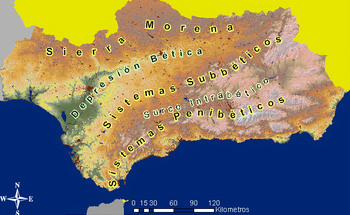

Mountain ranges affect climate, the network of rivers, soils and their erosion, bioregions, and even human economies insofar as they rely on natural resources.[55] The Andalusian terrain offers a range of altitudes and slopes. Andalusia has the Iberian peninsula's highest mountains and nearly 15 percent of its terrain over 1,000 metres (3,300 ft). The picture is similar for areas under 100 metres (330 ft) (with the Baetic Depression), and for the variety of slopes.
The Atlantic coast is overwhelmingly beach and gradually sloping coasts; the Mediterranean coast has many cliffs, above all in the Malagan Axarquía and in Granada and Almería.[56] This asymmetry divides the region naturally into Upper Andalusia (two mountainous areas) and Lower Andalusia (the broad basin of the Guadalquivir).[57]
The Sierra Morena separates Andalusia from the plains of Extremadura and Castile–La Mancha on Spain's Meseta Central. Although sparsely populated, this is not a particularly high range, and its highest point, the 1,323-metre (4,341 ft) peak of La Bañuela in the Sierra Madrona, lies outside of Andalusia. Within the Sierra Morena, the gorge of Despeñaperros forms a natural frontier between Castile and Andalusia.
The
Lower Andalusia, the Baetic Depression, the basin of the Guadalquivir, lies between these two mountainous areas. It is a nearly flat territory, open to the Gulf of Cádiz in the southwest. Throughout history, this has been the most populous part of Andalusia.
Hydrography

Andalusia has rivers that flow into both the Atlantic and the Mediterranean. Flowing to the Atlantic are the

The rivers of the Atlantic basin are characteristically long, run through mostly flat terrain, and have broad river valleys. As a result, at their mouths are estuaries and wetlands, such as the marshes of Doñana in the delta of the Guadalquivir, and wetlands of the Odiel. In contrast, the rivers of the Mediterranean Basin are shorter, more seasonal, and make a precipitous descent from the mountains of the Baetic Cordillera. Their estuaries are small, and their valleys are less suitable for agriculture. Also, being in the rain shadow of the Baetic Cordillera means that they receive a lesser volume of water.[57]
The following hydrographic basins can be distinguished in Andalusia. On the Atlantic side are the Guadalquivir basin; the Andalusian Atlantic Basin with the sub-basins Guadalete-Barbate and Tinto-Odiel; and the Guadiana basin. On the Mediterranean side is the Andalusian Mediterranean Basin and the upper portion of the
Soils
The soils of Andalusia can be divided into three large areas: the
The Sierra Morena, due to its morphology and the acidic content of its rocks, developed principally relatively poor, shallow soils, suitable only for forests. In the valleys and in some areas where limestone is present, deeper soils allowed farming of cereals suitable for livestock. The more complicated morphology of the Baetic Cordillera makes it more heterogeneous, with the most heterogeneous soils in Andalusia. Very roughly, in contrast to the Sierra Morena, a predominance of basic (alkaline) materials in the Cordillera Subbética, combined with a hilly landscape, generates deeper soils with greater agricultural capacity, suitable to the cultivation of olives.[62]
Finally, the Baetic Depression and the Surco Intrabético have deep, rich soils, with great agricultural capacity. In particular, the alluvial soils of the Guadalquivir valley and plain of Granada have a loamy texture and are particularly suitable for intensive irrigated crops.[63] In the hilly areas of the countryside, there is a double dynamic: the depressions have filled with older lime-rich material, developing the deep, rich, dark clay soils the Spanish call bujeo, or tierras negras andaluzas, excellent for dryland farming. In other zones, the whiter albariza provides an excellent soil for vineyards.[64]
Despite their marginal quality, the poorly consolidated soils of the sandy coastline of Huelva and Almería have been successfully used in recent decades for hothouse cultivation under clear plastic of strawberries, raspberries, blueberries, and other fruits.
Flora

Biogeographically, Andalusia forms part of the Western Mediterranean subregion of the Mediterranean Basin, which falls within the Boreal Kingdom. Five floristic provinces lie, in whole or in part, within Andalusia: along much of the Atlantic coast, the Lusitanian-Andalusian littoral or Andalusian Atlantic littoral; in the north, the southern portion of the Luso-Extremaduran floristic province; covering roughly half of the region, the Baetic floristic province; and in the extreme east, the Almerian portion of the Almerian-Murcian floristic province and (coinciding roughly with the upper Segura basin) a small portion of the Castilian-Maestrazgan-Manchegan floristic province. These names derive primarily from past or present political geography: "Luso" and "Lusitanian" from Lusitania, one of three Roman provinces in Iberia, most of the others from present-day Spanish provinces, and Maestrazgo being a historical region of northern Valencia.

In broad terms, the typical vegetation of Andalusia is
The Andalusian woodlands have been much altered by human settlement, the use of nearly all of the best land for farming, and frequent wildfires. The degraded forests become shrubby and combustible garrigue. Extensive areas have been planted with non-climax trees such as pines. There is now a clear conservation policy for the remaining forests, which survive almost exclusively in the mountains.
Fauna
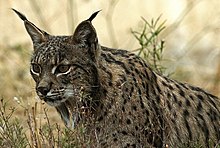
The biodiversity of Andalusia extends to its fauna as well. More than 400 of the 630 vertebrate species extant in Spain can be found in Andalusia. Spanning the Mediterranean and Atlantic basins, and adjacent to the Strait of Gibraltar, Andalusia is on the migratory route of many of the numerous flocks of birds that travel annually from Europe to Africa and back.[66]
The Andalusian wetlands host a rich variety of birds. Some are of African origin, such as the
(Milvus migrans and Milvus milvus).
Among the
The large
Other notable species are
Protected areas
Andalusia has many unique ecosystems. In order to preserve these areas in a manner compatible with both conservation and economic exploitation, many of the most representative ecosystems have been given protected status.[68][69]
The various levels of protection are encompassed within the Network of Protected Natural Spaces of Andalusia (Red de Espacios Naturales Protegidos de Andalucía, RENPA) which integrates all protected natural spaces located in Andalusia, whether they are protected at the level of the local community, the autonomous community of Andalusia, the Spanish state, or by international conventions. RENPA consists of 150 protected spaces, consisting of two
In total, nearly 20 percent of the territory of Andalusia lies in one of these protected areas, which constitute roughly 30 percent of the protected territory of Spain.[70] Among these many spaces, some of the most notable are the Sierras de Cazorla, Segura y Las Villas Natural Park, Spain's largest natural park and the second largest in Europe, the Sierra Nevada National Park, Doñana National Park and Natural Park, the Tabernas Desert, and the Cabo de Gata-Níjar Natural Park, the largest terrestrial-maritime reserve in the European Western Mediterranean Sea.
History

The geostrategic position of Andalusia in the extreme south of Europe, providing (along with Morocco) a gateway between Europe and Africa, added to its position between the Atlantic Ocean and the Mediterranean Sea, as well as its rich deposits of minerals and its agricultural wealth, have made Andalusia a tempting prize for civilizations since prehistoric times. Add to this its area of 87,268 square kilometres (33,694 sq mi) (larger than many European countries), and it can be no surprise that Andalusia has figured prominently in the history of Europe and the Mediterranean.
Several theories postulate that the first
Carthaginians and Romans

With the fall of the original
Vandals, Visigoths and the Byzantine Empire
The Vandals moved briefly through the region during the 5th century AD before settling in North Africa, after which the region fell into the hands of the
Al-Andalus states

The Visigothic era came to an abrupt end in 711 with the
The mosque's hypostyle plan, consisting of a rectangular prayer hall and an enclosed courtyard, followed a tradition established in the Umayyad and Abbasid mosques of Syria and Iraq while the dramatic articulation of the interior of the prayer hall was unprecedented. The system of columns supporting double arcades of piers and arches with alternating red and white voussoirs is an unusual treatment that, structurally, combined striking visual effect with the practical advantage of providing greater height within the hall. Alternating red and white voussoirs are associated with Umayyad monuments such as the Great Mosque of Damascus and the Dome of the Rock. Their use in the Great Mosque of Córdoba manages to create a stunningly original visual composition even as it emphasises 'Abd al-Rahman's connection to the established Umayyad tradition.[74]
In this period, the name "Al-Andalus" was applied to the Iberian Peninsula, and later it referred to the parts not controlled by the Gothic states in the North. The Muslim rulers in Al-Andalus were economic invaders and interested in collecting taxes; social changes imposed on the native populace were mainly confined to geographical, political and legal conveniences.[citation needed] Al-Andalus remained connected to other states under Muslim rule; also trade routes between it and Constantinople and Alexandria remained open, while many cultural features of the Roman Empire were transmitted throughout Europe and the Near East by its successor state, the Byzantine Empire. Byzantine architecture is an example of such cultural diffusion continuing even after the collapse of the empire.[75]
Nevertheless, the
By the 10th century, the northern Kingdoms of Spain and other European Crowns had begun what would eventually become the Reconquista: the reconquest of the Iberian Peninsula for Christendom. Caliph Abd-ar-Rahman suffered some minor military defeats, but often managed to manipulate the Gothic northern kingdoms to act against each other's interests. Al-Hakam achieved military successes, but at the expense of uniting the north against him. In the 10th century the Saracen rulers of Andalusia had a Slavic army of 13,750 men.[77]
After the conquest of Toledo in 1086 by
After the victory at the
Crown of Castile
The weakness caused by the collapse of Almohad power and the subsequent creation of new Taifas, each with its own ruler, led to the rapid Castile reconquest of the valley of the Guadalquivir. Córdoba was regained in 1236 and Seville in 1248. The

Seven months later, on 3 August 1492
Contacts between Spain and the Americas, including royal administration and the shipping trade from Asia and America for over three hundred years, came almost exclusively through the south of Spain, specially Seville and Cadiz ports.[81]
As a result, it became the wealthiest, most influential region in Spain and amongst the most influential in Europe. For example, the
Habsburg Spain
In the first half of the 16th century plague was still prevalent in Spain. According to George C. Kohn, "One of the worst epidemics of the century, whose miseries were accompanied by severe drought and food shortage, started in 1505; by 1507, about 100,000 people had died in Andalusia alone. Andalusia was struck once again in 1646. For three years, plague haunted the entire region, causing perhaps as many as 200,000 deaths, especially in Málaga and Seville."[83]

A second insurrection, the
In 1810–12 Spanish troops strongly resisted the French occupation during the Peninsular War (part of the Napoleonic Wars).[85]
Andalusia profited from the Spanish overseas empire, although much trade and finance eventually came to be controlled by other parts of Europe to where it was ultimately destined. In the 18th century, commerce from other parts of Spain began to displace Andalusian commerce when the Spanish government ended Andalusia's trading monopoly with the colonies in the Americas. The loss of the empire in the 1820s hurt the economy of the region, particularly the cities that had benefited from the trade and ship building. The construction of railways in the latter part of the 19th century enabled Andalusia to better develop its agricultural potential and it became an exporter of food. While industrialisation was taking off in the northern Spanish regions of Catalonia and the Basque country, Andalusia remained traditional and displayed a deep social division between a small class of wealthy landowners and a population made up largely of poor agricultural labourers and tradesmen.[citation needed]
Francoist oppressions

Andalusia was one of the worst-affected regions of Spain by Francisco Franco's brutal campaign of mass-murder and political suppression called the White Terror during and after the Spanish Civil War. The Nationalist rebels bombed and seized the working-class districts of the main Andalusian cities in the first days of the war,[86] and afterwards went on to execute thousands of workers and militants of the leftist parties: in the city of Córdoba 4,000;[87] in the city of Granada 5,000;[88] in the city of Seville 3,028;[89] and in the city of Huelva 2,000 killed and 2,500 disappeared.[90] The city of Málaga, occupied by the Nationalists in February 1937 following the Battle of Málaga, experienced one of the harshest repressions following Francoist victory with an estimated total of 17,000 people summarily executed.[91][92][93][94] Carlos Arias Navarro, then a young lawyer who as public prosecutor signed thousands of execution warrants in the trials set up by the triumphant rightists, became known as "The Butcher of Málaga" (Carnicero de Málaga).[95]
Paul Preston estimates the total number of victims of deliberately killed by the Nationalists in Andalusia at 55,000.[96]
Government and politics

Andalusia is one of the 17
The Autonomous Community of Andalusia was formed in accord with a referendum of 28 February 1980
Article 1 of the 1981 Statute of Autonomy justifies autonomy based on the region's "historical identity, on the self-government that the Constitution permits every nationality, on outright equality to the rest of the nationalities and regions that compose Spain, and with a power that emanates from the Andalusian Constitution and people, reflected in its Statute of Autonomy".[98]
In October 2006 the constitutional commission of the Cortes Generales (the national legislature of Spain), with favorable votes from the left-of-center Spanish Socialist Workers' Party (PSOE), the leftist United Left (IU) and the right-of-center People's Party (PP), approved a new Statute of Autonomy for Andalusia, whose preamble refers to the community as a "national reality" (realidad nacional):
The Andalusianist Manifesto of Córdoba described Andalusia as a national reality in 1919, whose spirit the Andalusians took up outright through the process of self-government recognized in our Magna Carta. In 1978 the Andalusians broadly backed the constitutional consensus. Today, the Constitution, in its Article 2, recognizes Andalusia as a nationality as part of the indissoluble unity of the Spanish nation.[36]
— Andalusian Statute of Autonomy on Wikisource, in Spanish
On 2 November 2006 the Spanish Chamber Deputies ratified the text of the Constitutional Commission with 306 votes in favor, none opposed, and 2 abstentions. This was the first time a Spanish Organic Law adopting a Statute of Autonomy was approved with no opposing votes. The Senate, in a plenary session of 20 December 2006, ratified the referendum to be voted upon by the Andalusian public 18 February 2007.
The Statute of Autonomy spells out Andalusia's distinct institutions of government and administration. Chief among these is the
The Andalusian Statute of Autonomy recognizes Seville as the autonomy's capital. The Andalusian Autonomous Government is located there. The region's highest court, the
Autonomous Government


The Andalusian Autonomous Government (Junta de Andalucía) is the institution of self-government of the Autonomous Community of Andalusia. Within the government, the
The Council of Government, the highest political and administrative organ of the Community, exercises
The Parliament of Andalusia, its Autonomic Legislative Assembly, develops and approves laws and elects and removes the President.[102] Elections to the Andalusian Parliament follow a democratic formula through which the citizens elect 109 representatives. After the approval of the Statute of Autonomy through Organic Law 6/1981 on 20 December 1981, the first elections to the autonomic parliament took place 23 May 1982. Further elections have occurred in 1986, 1990, 1994, 1996, 2000, 2004, and 2008.
The current (2008–2012) legislature includes representatives of the PSOE-A (Andalusian branch of the left-of-center PSOE), PP-A (Andalusian branch of the right-of-center PP) and IULV-CA (Andalusian branch of the leftist IU).[103]
Judicial power
The
Administrative divisions
Provinces


Andalusia consists of eight provinces. The latter were established by Javier de Burgos in the 1833 territorial division of Spain. Each of the Andalusian provinces bears the same name as its capital:[105]
| Province | Capital | Population | Density | Municipalities | Legal districts |
|---|---|---|---|---|---|
| Almería | 753,920 | 85.9/km2 (222/sq mi) | 102 municipalities | 8 | |
| Cádiz | 1,250,539 | 168.1/km2 (435/sq mi) | 44 municipalities | 14 | |
Córdoba |
773,997 | 56.2/km2 (146/sq mi) | 75 municipalities | 12 | |
| Granada | 930,181 | 73.5/km2 (190/sq mi) | 170 municipalities | 9 | |
| Huelva | 530,824 | 52.4/km2 (136/sq mi) | 79 municipalities | 6 | |
| Jaén | 620,242 | 45.9/km2 (119/sq mi) | 97 municipalities | 10 | |
| Málaga | 1,751,600 | 239.7/km2 (621/sq mi) | 102 municipalities | 11 | |
| Seville | 1,957,210 | 139.4/km2 (361/sq mi) | 105 municipalities | 15 |
Andalusia is traditionally divided into two historical subregions: Upper Andalusia or Eastern Andalusia (Andalucía Oriental), consisting of the provinces of Almería, Granada, Jaén, and Málaga, and Lower Andalusia or Western Andalusia (Andalucía Occidental), consisting of the provinces of Cádiz, Córdoba, Huelva and Seville.
Comarcas and mancomunidades

Within the various autonomous communities of Spain, comarcas are comparable to shires (or, in some countries, counties) in the English-speaking world. Unlike in some of Spain's other autonomous communities, under the original 1981 Statute of Autonomy, the comarcas of Andalusia had no formal recognition, but, in practice, they still had informal recognition as geographic, cultural, historical, or in some cases administrative entities. The 2007 Statute of Autonomy echoes this practice, and mentions comarcas in Article 97 of Title III, which defines the significance of comarcas and establishes a basis for formal recognition in future legislation.[106]
The current statutory entity that most closely resembles a comarca is the mancomunidad, a freely chosen, bottom-up association of municipalities intended as an instrument of socioeconomic development and coordination between municipal governments in specific areas.[105][107]
Municipalities and local entities
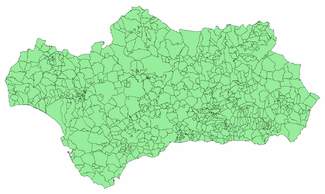
Beyond the level of provinces, Andalusia is further divided into 774 municipalities (municipios).[105] The municipalities of Andalusia are regulated by Title III of the Statute of Autonomy, Articles 91–95, which establishes the municipality as the basic territorial entity of Andalusia, each of which has legal personhood and autonomy in many aspects of its internal affairs. At the municipal level, representation, government and administration is performed by the ayuntamiento (municipal government), which has competency for urban planning, community social services, supply and treatment of water, collection and treatment of waste, and promotion of tourism, culture, and sports, among other matters established by law.[108]
In conformity with the intent to devolve control as locally as possible, in many cases, separate nuclei of population within municipal borders each administer their own interests. These are variously known as pedanías ("hamlets"), villas ("villages"), aldeas (also usually rendered as "villages"), or other similar names.[105]
Demographics
Andalusia ranks first by population among the 17 autonomous communities of Spain. The estimated population at the beginning of 2023 was 8,538,376. The population is concentrated, above all, in the provincial capitals and along the coasts, so that the level of urbanization is quite high; half the population is concentrated in the 28 cities of more than 50,000 inhabitants. The population is aging, although the process of immigration is countering the inversion of the population pyramid.[109]
Main cities
| Rank | Province | Pop. | Rank | Province | Pop. | ||||
|---|---|---|---|---|---|---|---|---|---|
 Seville  Málaga |
1 | Seville | Seville | 684,025 | 11 | Jaén | Jaén | 111,888 |  Córdoba  Granada |
| 2 | Málaga | Málaga | 586,384 | 12 | Cádiz | Cádiz | 111,811 | ||
| 3 | Córdoba | Córdoba | 323,763 | 13 | Roquetas de Mar | Almería | 106,510 | ||
| 4 | Granada | Granada | 230,595 | 14 | San Fernando | Cádiz | 93,927 | ||
| 5 | Jerez de la Frontera | Cádiz | 213,231 | 15 | Mijas | Málaga | 91,691 | ||
| 6 | Almería | Almería | 200,578 | 16 | El Ejido | Almería | 89,975 | ||
| 7 | Marbella | Málaga | 156,295 | 17 | El Puerto de Santa María | Cádiz | 89,813 | ||
| 8 | Huelva | Huelva | 142,532 | 18 | Chiclana de la Frontera | Cádiz | 88,709 | ||
| 9 | Dos Hermanas | Seville | 138,981 | 19 | Fuengirola | Málaga | 85,598 | ||
| 10 | Algeciras | Cádiz | 123,639 | 20 | Vélez-Málaga | Málaga | 85,377 | ||
Population change
| Year | Pop. | ±% |
|---|---|---|
| 1900 | 3,544,769 | — |
| 1910 | 3,800,299 | +7.2% |
| 1920 | 4,221,686 | +11.1% |
| 1930 | 4,627,148 | +9.6% |
| 1940 | 5,255,120 | +13.6% |
| 1950 | 5,647,244 | +7.5% |
| 1960 | 5,940,067 | +5.2% |
| 1970 | 5,991,076 | +0.9% |
| 1981 | 6,441,149 | +7.5% |
| 1991 | 6,940,542 | +7.8% |
| 2001 | 7,357,558 | +6.0% |
| 2011 | 8,371,270 | +13.8% |
| 2021 | 8,484,804 | +1.4% |
| 2023 | 8,538,376 | +0.6% |
| Source: INE | ||
At the end of the 20th century, Andalusia was in the last phase of
At the beginning of the 21st century, statistics show a slight increase in the birth rate, due in large part to the higher birth rate among immigrants.[114][115] The result is that as of 2009, the trend toward rejuvenation of the population is among the strongest of any autonomous community of Spain, or of any comparable region in Europe.[113]
Structure
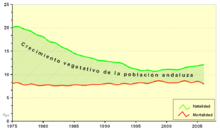
At the beginning of the 21st century, the population structure of Andalusia shows a clear inversion of the population pyramid, with the largest cohorts falling between ages 25 and 50.[116] Comparison of the population pyramid in 2008 to that in 1986 shows:
- A clear decrease in the population under the age of 25, due to a declining birth rate.
- An increase in the adult population, as the earlier, larger cohort born in the "baby boom" of the 1960s and 1970s reach adulthood. This effect has been exacerbated by immigration: the largest contingent of immigrants are young adults.
- A further increase in the adult population, and especially the older adult population, due to increased life expectancy.
As far as composition by sex, two aspects stand out: the higher percentage of women in the elderly population, owing to women's longer life expectancy, and, on the other hand, the higher percentage of men of working age, due in large part to a predominantly male immigrant population.[113]
Immigration
In 2005, 5.35 percent of the population of Andalusia were born outside of Spain. This is a relatively low number for a Spanish region, the national average being three percentage points higher. The immigrants are not evenly distributed among the Andalusian provinces: Almería, with a 15.20 percent immigrant population, is third among all provinces in Spain, while at the other extreme Jaén is only 2.07 percent immigrants and Córdoba 1.77 percent. The predominant nationalities among the immigrant populations are Moroccan (92,500, constituting 17.79 percent of the foreigners living in Andalusia) and British (15.25 percent across the region). When comparing world regions rather than individual countries, the single largest immigrant block is from the region of Latin America, outnumbering not only all North Africans, but also all non-Spanish Western Europeans.[117] Demographically, this group has provided an important addition to the Andalusian labor force.[114][115]
| Foreign Population by Nationality[118] | Number | % |
| 2022 | ||
| TOTAL FOREIGNERS | 741,378 | |
| EUROPE | 342,463 | |
| EUROPEAN UNION | 206,934 | |
| OTHER EUROPE | 135,529 | |
| AFRICA | 211,443 | |
| SOUTH AMERICA | 102,938 | |
| CENTRAL AMERICA | 30,160 | |
| NORTH AMERICA | 11,446 | |
| ASIA | 41,811 | |
| OCEANIA | 573 | |
| Instituto Nacional de Estadística | ||
Economy
Andalusia is traditionally an agricultural area, but the
Between 2000 and 2006 economic growth per annum was 3.72%, one of the highest in the country. Still, according to the Spanish
| Andalusia | Almería | Cádiz | Córdoba | Granada | Huelva | Jaén | Málaga | Seville | |
|---|---|---|---|---|---|---|---|---|---|
| GDP (thousands of €) | 154,011,654 | 14,124,024 | 21,430,772 | 13,000,521 | 16,403,614 | 9,716,037 | 10,036,091 | 31,331,122 | 37,969,433 |
| GDP per capita (€) | 18,360 | 20,054 | 17,284 | 16,422 | 17,919 | 18,699 | 15,481 | 19,229 | 19,574 |
| Workers | 2,990,143 | 286,714 | 387,174 | 264,072 | 309,309 | 196,527 | 220,877 | 607,255 | 718,215 |
| GDP (%) | 100 | 9.17 | 13.92 | 8.44 | 10.65 | 6.31 | 6.52 | 20.34 | 24.65 |
Primary sector
The
The primary sector is divided into a number of subsectors: agriculture, commercial fishing, animal husbandry, hunting, forestry, mining, and energy.
Agriculture, husbandry, hunting, and forestry
For many centuries, agriculture dominated Andalusian society, and, with 44.3 percent of its territory cultivated and 8.4 percent of its workforce in agriculture as of 2016 it remains an integral part of Andalusia's economy.

The most important tree crops are
In monetary terms, by far the most productive and competitive agriculture in Andalusia is the intensive forced cultivation of strawberries, raspberries, blueberries, and other fruits grown under hothouse conditions under clear plastic, often in sandy zones, on the coasts, in Almería and Huelva.[129]

Organic farming has recently undergone rapid expansion in Andalusia, mainly for export to European markets but with increasing demand developing in Spain.[130]
Andalusia has a long tradition of animal husbandry and livestock farming, but it is now restricted mainly to mountain meadows, where there is less pressure from other potential uses. Andalusians have a long and colourful history of dog breeding that can be observed throughout the region today. The raising of livestock now plays a semi-marginal role in the Andalusian economy, constituting only 15 percent of the primary sector, half the number for Spain taken as a whole.[131]
"Extensive" raising of livestock grazes the animals on natural or cultivated pastures, whereas "intensive" raising of livestock is based in fodder rather than pasture. Although the productivity is higher than with extensive techniques, the economics are quite different. While intensive techniques now dominate in Europe and even in other regions of Spain, most of Andalusia's cattle, virtually all of its sheep and goats, and a good portion of its pigs are raised by extensive farming in mountain pastures. This includes the Black Iberian pigs that are the source of Jamón ibérico. Andalusia's native sheep and goats present a great economic opportunity in a Europe where animal products are generally in strong supply, but the sheep and goat meat, milk, and leather (and the products derived from these) are relatively scarce. Dogs are bred not just as companion animals, but also as herding animals used by goat and sheep herders.
Hunting remains relatively important in Andalusia, but has largely lost its character as a means of obtaining food. It is now more of a leisure activity linked to the mountain areas and complementary to forestry and the raising of livestock.[132] Dogs are frequently used as hunting companions to retrieve killed game.
The Andalusian
Fishing

Fishing is a longstanding tradition on the Andalusian coasts. Fish and other seafood have long figured prominently in the local diet and in the local gastronomic culture: fried fish (pescaito frito in local dialect), white prawns, almadraba tuna, among others. The Andalusian fishing fleet is Spain's second largest, after Galicia, and Andalusia's 38 fishing ports are the most of any Spanish autonomous community.[135] Commercial fishing produces only 0.5 percent of the product of the regional primary sector by value, but there are areas where it has far greater importance. In the province of Huelva it constitutes 20 percent of the primary sector, and locally in Punta Umbría 70 percent of the work force is involved in commercial fishing.[136]
Failure to comply with fisheries laws regarding the use of trawling, urban pollution of the seacoast, destruction of habitats by coastal construction (for example, alteration of the mouths of rivers, construction of ports), and diminution of fisheries by overexploitation[137] have created a permanent crisis in the Andalusian fisheries, justifying attempts to convert the fishing fleet. The decrease in fish stocks has led to the rise of aquaculture, including fish farming both on the coasts and in the interior.[138]
Mining

Despite the general poor returns in recent years,
Secondary sector: industry
The Andalusian industrial sector has always been relatively small. Nevertheless, in 2007, Andalusian industry earned 11.979 million euros and employed more than 290,000 workers. This represented 9.15 percent of regional GDP, far below the 15.08 the secondary sector represents in the economy of Spain as a whole.[140] By analyzing the different subsectors of the food industry Andalusian industry accounts for more than 16% of total production. In a comparison with the Spanish economy, this subsector is virtually the only food that has some weight in the national economy with 16.16%. Lies far behind the manufacturing sector of shipping materials just over 10% of the Spanish economy. Companies like Cruzcampo (Heineken Group), Puleva, Domecq, Santana Motors or Renault-Andalusia, are exponents of these two subsectors. Of note is the Andalusian aeronautical sector, which is second nationally only behind Madrid and represents approximately 21% of total turnover in terms of employment, highlighting companies like Airbus, Airbus Military, or the newly formed Aerospace Alestis. On the contrary it is symptomatic of how little weight the regional economy in such important sectors such as textiles or electronics at the national level.[citation needed]
Andalusian industry is also characterized by a specialization in industrial activities of transforming raw agricultural and mineral materials. This is largely done by small enterprises without the public or foreign investment more typical of a high level of industrialization.
Tertiary sector: services

In recent decades the Andalusian tertiary (service) sector has grown greatly, and has come to constitute the majority of the regional economy, as is typical of contemporary economies in developed nations.
1. Andalusian capital found it impossible to compete in the industrial sector against more developed regions, and was obligated to invest in sectors that were easier to enter.
2. The absence of an industrial sector that could absorb displaced agricultural workers and artisans led to the proliferation of services with rather low productivity. This unequal development compared to other regions led to a hypertrophied and unproductive service sector, which has tended to reinforce underdevelopment, because it has not led to large accumulations of capital.[142][143]
Tourism in Andalusia





Due in part to the relatively mild winter and spring climate, the south of Spain is attractive to overseas visitors–especially tourists from Northern Europe. While inland areas such as
Among the autonomous communities, Andalusia is second only to Catalonia in tourism, with nearly 30 million visitors every year. The principal tourist destinations in Andalusia are the Costa del Sol and (secondarily) the Sierra Nevada. As discussed above, Andalusia is one of the sunniest and warmest places in Europe, making it a center of "sun and sand" tourism,[144] but not only it. Around 70 percent of the lodging capacity and 75 percent of the nights booked in Andalusian hotels are in coastal municipalities. The largest number of tourists come in August—13.26 percent of the nights booked throughout the year—and the smallest number in December—5.36 percent.
On the west (Atlantic) coast are the
Together with "sand and sun" tourism, there has also been a strong increase in nature tourism in the interior, as well as cultural tourism, sport tourism, and conventions.[citation needed] One example of sport and nature tourism is the ski resort at Sierra Nevada National Park.
As for cultural tourism, there are hundreds of cultural tourist destinations: cathedrals, castles, forts, monasteries, and historic city centers and a wide variety of museums.
It can be highlighted that Spain has seven of its 42 cultural UNESCO World Heritage Sites in Andalucia:
- Alhambra, Generalife and Albayzín, Granada (1984,1994)
- Antequera Dolmens Site (2016)
- 10th Century Caliphate City of Medina Azahara(2018)
- Cathedral, Alcázar and Archivo de Indias in Seville (1987)
- Historic centre of Córdoba (1984,1994)
- Renaissance Monumental Ensembles of Úbeda and Baeza (2003)
- Rock Art of the Mediterranean Basin on the Iberian Peninsula (1998)
Further, there are the near Tarifa.
Andalusia was the birthplace of such great painters as
There are numerous other significant museums around the region, both of paintings and of archeological artifacts such as gold jewelry, pottery and other ceramics, and other works that demonstrate the region's artisanal traditions.
The Council of Government has designated the following "Municipios Turísticos": in Almería, Roquetas de Mar; in Cádiz, Chiclana de la Frontera, Chipiona, Conil de la Frontera, Grazalema, Rota, and Tarifa; in Granada, Almuñécar; in Huelva, Aracena; in Jaén, Cazorla; in Málaga, Benalmádena, Fuengirola, Nerja, Rincón de la Victoria, Ronda, and Torremolinos; in Seville, Santiponce.
Monuments and features
- Alcazaba, Almería
- Cueva de Menga, Antequera (Málaga)
- El Torcal, Antequera (Málaga)
- Córdoba
- Córdoba
- Mudejar Quarter, Frigiliana (Málaga)
- Alhambra, Granada
- Palace of Charles V, Granada
- Charterhouse, Granada
- Albayzín, Granada
- La Rabida Monastery, Palos de la Frontera (Huelva)
- Castle of Santa Catalina, Jaén
- Jaén Cathedral, Jaén
- Úbeda and Baeza, Jaén
- Alcazaba, Málaga
- Buenavista Palace, Málaga
- Málaga Cathedral, Málaga
- Puente Nuevo, Ronda (Málaga)
- Caves of Nerja, Nerja (Málaga)
- Ronda Bullring, Ronda (Málaga)
- Giralda, Seville
- Torre del Oro, Seville
- Plaza de España, Seville
- Seville Cathedral, Seville
- Alcázar of Seville, Seville
- Almonaster la Real Mosque, Almonaster la Real (Huelva)
Unemployment
The unemployment rate stood at 25.5% in 2017 and was one of the highest in Spain and Europe.[152]
| Year | 2006 | 2007 | 2008 | 2009 | 2010 | 2011 | 2012 | 2013 | 2014 | 2015 | 2016 | 2017 |
|---|---|---|---|---|---|---|---|---|---|---|---|---|
| unemployment rate (in %) |
12.6% | 12.8% | 17.7% | 25.2% | 27.8% | 30.1% | 34.4% | 36.2% | 34.8% | 31.5% | 28.9% | 25.5% |
Infrastructure
Transport

As in any modern society, transport systems are an essential structural element of the functioning of Andalusia. The transportation network facilitates territorial coordination, economic development and distribution, and intercity transportation.[153]
In urban transport, underdeveloped public transport systems put pedestrian traffic and other non-motorized traffic are at a disadvantage compared to the use of private vehicles. Several Andalusian capitals—Córdoba, Granada and Seville—have recently been trying to remedy this by strengthening their public transport systems and providing a better infrastructure for the use of bicycles.[154] There are now three rapid transit systems operating in Andalucia – the Seville Metro, Málaga Metro and Granada Metro. Cercanías commuter rail networks operate in Seville, Málaga and Cádiz.

For over a century, the conventional rail network has been centralized on the regional capital, Seville, and the national capital, Madrid; in general, there are no direct connections between provincial capitals. High-speed AVE trains run from Madrid via Córdoba to Seville and Málaga, from which a branch from Antequera to Granada opened in 2019. Further AVE routes are under construction.[155] The Madrid-Córdoba-Seville route was the first high-velocity route in Spain (operating since 1992). Other principal routes are the one from Algeciras to Seville and from Almería via Granada to Madrid.
Most of the principal roads have been converted into
Other first-order roads include the

As of 2008 Andalusia has six public airports, all of which can legally handle international flights. The Málaga Airport is dominant, handling 60.67 percent of passengers[156] and 85 percent of its international traffic.[157] The Seville Airport handles another 20.12 percent of traffic, and the Jerez Airport 7.17 percent, so that these three airports account for 87.96 percent of traffic.[156]
Málaga Airport is the international airport that offers a wide variety of international destinations. It has a daily link with twenty cities in Spain and over a hundred cities in Europe (mainly in Great Britain, Central Europe and the Nordic countries but also the main cities of Eastern Europe: Moscow, Saint Petersburg, Sofia, Riga or Bucharest), North Africa, Middle East (Riyadh, Jeddah and Kuwait) and North America (New York, Toronto and Montreal).

The main ports are Algeciras (for freight and container traffic) and Málaga for cruise ships. Algeciras is Spain's leading commercial port, with 60,000,000 tonnes (66,000,000 short tons) of cargo in 2004.[158] Seville has Spain's only commercial river port. Other significant commercial ports in Andalusia are the ports of the Bay of Cádiz, Almería and Huelva.
The Council of Government has approved a Plan of Infrastructures for the Sustainability of Transport in Andalusia (PISTA) 2007–2013, which plans an investment of 30 billion euros during that period.[159]
Energy infrastructure

The lack of high-quality
The infrastructure for production of
The largest wind power firm in the region is the Sociedad Eólica de Andalucía, formed by the merger of Planta Eólica del Sur S.A. and Energía Eólica del Estrecho S.A.
The Medgaz gas pipeline directly connects the Algerian town of Béni Saf to Almería.[163]
Education

As throughout Spain, basic education in Andalusia is free and compulsory. Students are required to complete ten years of schooling, and may not leave school before the age of 16, after which students may continue on to a baccalaureate, to intermediate vocational education, to intermediate-level schooling in arts and design, to intermediate sports studies, or to the working world.
Andalusia has a tradition of higher education dating back to the
.As of 2009,[update] there were ten private or public universities in Andalusia. University studies are structured in cycles, awarding degrees based on
Healthcare
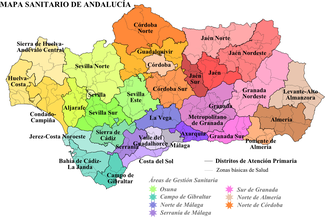
Responsibility for healthcare jurisdictions devolved from the Spanish government to Andalusia with the enactment of the Statute of Autonomy. Thus, the Andalusian Health Service (Servicio Andaluz de Salud) currently manages almost all public health resources of the Community, with such exceptions as health resources for prisoners and members of the military, which remain under central administration.
Science and technology
According to the Outreach Program for Science in Andalusia, Andalusia contributes 14 percent of Spain's scientific production behind only Madrid and Catalonia among the autonomous communities,
The Council of Innovation, Science and Business is the organ of the autonomous government responsible for universities, research, technological development, industry, and energy. The council coordinates and initiates scientific and technical innovation through specialized centers an initiatives such as the Andalusian Center for Marine Science and Technology (Centro Andaluz de Ciencia y Tecnología Marina) and Technological Corporation of Andalusia (Corporación Tecnológica de Andalucía).
Within the private sphere, although also promoted by public administration, technology parks have been established throughout the Community, such as the
Media
Andalusia has international, national, regional, and local media organizations, which are active gathering and disseminating information (as well as creating and disseminating entertainment).
The most notable is the public Radio y Televisión de Andalucía (RTVA), broadcasting on two regional television channels, Canal Sur and Canal Sur 2, four regional radio stations, Canal Sur Radio, Canal Fiesta Radio, Radio Andalucía Información and Canal Flamenco Radio, as well as various digital signals, most notably Canal Sur Andalucía available on cable TV throughout Spain.[166]
Newspapers
Different newspapers are published for each Andalusian provincial capital, comarca, or important city. Often, the same newspaper organization publishes different local editions with much shared content, with different mastheads and different local coverage. There are also popular papers distributed without charge, again typically with local editions that share much of their content.
No single Andalusian newspaper is distributed throughout the region, not even with local editions. In eastern Andalusia the
Public television
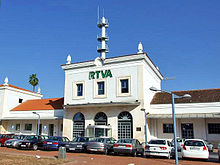
Andalusia has two public television stations, both operated by Radio y Televisión de Andalucía (RTVA):
- Canal Sur first broadcast on 28 February 1989 (Andalusia Day).
- Canal Sur 2 first broadcast 5 June 1998. Programming focuses on culture, sports, and programs for children and youth.
In addition, RTVA also operates the national and international cable channel Canal Sur Andalucía, which first broadcast in 1996 as Andalucía Televisión.
Radio
There are four public radio stations in the region, all operated by RTVA:
- Canal Sur Radio, first broadcast October 1988.
- Radio Andalucía Información, first broadcast September 1998.
- Canal Fiesta Radio, first broadcast January 2001.
- Canal Flamenco Radio, first broadcast 29 September 2008.
Art and culture
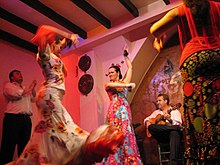
The patrimony of Andalusia has been shaped by its particular history and geography, as well as its complex flows of population. Andalusia has been home to a succession of peoples and civilizations, many very different from one another, each impacting the settled inhabitants. The ancient
In the 19th century, Andalusian culture came to be widely viewed as the Spanish culture par excellence, in part thanks to the perceptions of romantic travellers. In the words of Ortega y Gasset:
Andalusia, which has never shown the swagger nor petulancy of particularism; that has never pretended to the status of a State apart, is, of all the Spanish regions, the one that possesses a culture most radically its own. Throughout the 19th century, Spain has submitted itself to the hegemonic influence of Andalusia. That century began with the Cortes of Cádiz; it ended with the assassination of Cánovas del Castillo, malagueño [from Málaga], and the exaltation of Silvela, no less malagueño. The dominant ideas have an Andalusian accent. One paints Andalusia: a roof-terrace, some flowerpots, blue sky. One reads southern authors. One speaks at all times of the "land of the Most Holy Virgin Mary". The thief from the Sierra Morena and the smuggler are national heroes. All Spain feels its existence justified by the honor of having on its flanks the Andalusian piece of the planet. Around 1900, like so many other things, this changes. The North sits up.[169]
— Ortega y Gasset, Teoría de Andalucía, 1927
Arts

Andalusia has been the birthplace of many great artists: the classic painters Velázquez, Murillo, and Juan de Valdés Leal; the sculptors Juan Martínez Montañés, Alonso Cano and Pedro de Mena; and such modern painters as Daniel Vázquez Díaz and Pablo Picasso.
The Spanish composer
Architecture

Since the
Some of the greatest architecture in Andalusia was developed across several centuries and civilizations, and the region is particularly famous for its Islamic and Moorish architecture, which includes the Alhambra complex, Generalife[171] and the Mosque-Cathedral of Córdoba.
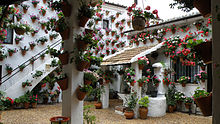
The traditional architecture of Andalusia retains its
Besides the architecture of the cities, there is also much outstanding rural architecture: houses, as well as ranch and farm buildings and
Sculpture
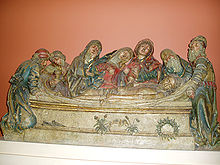
The
The
Non-religious sculpture has also existed in Andalusia since antiquity. A fine example from the Renaissance era is the decoration of the Casa de Pilatos in Seville. Nonetheless, non-religious sculpture played a relatively minor role until such 19th-century sculptors as Antonio Susillo.
Painting
As in sculpture, there were
A specific
Málaga also has been and is an important artistic center. Its most illustrious representative was Pablo Picasso, one of the most influential artists of the 20th century. The city has a Museum and Natal House Foundation, dedicated to the painter.
Literature and philosophy

Andalusia plays a significant role in the history of Spanish-language literature, although not all of the important literature associated with Andalusia was written in Spanish. Before 1492, there was the literature written in
In 1492 Antonio de Nebrija published his celebrated Gramática de la lengua castellana ("Grammar of the Castilian language"), the first such work for a modern European language. In 1528 Francisco Delicado wrote La lozana andaluza, a novel in the orbit of La Celestina, and in 1599 the Sevillian Mateo Alemán wrote the first part of Guzmán de Alfarache, the first picaresque novel with a known author.
The prominent
Literary Romanticism in Spain had one of its great centers in Andalusia, with such authors as Ángel de Saavedra, 3rd Duke of Rivas, José Cadalso and Gustavo Adolfo Bécquer. Costumbrismo andaluz existed in literature as much as in visual art, with notable examples being the Escenas andaluzas of Serafín Estébanez Calderón and the works of Pedro Antonio de Alarcón.
Andalusian authors Ángel Ganivet, Manuel Gómez-Moreno, Manuel and Antonio Machado, and Francisco Villaespesa are all generally counted in the Generation of '98. Also of this generation were the Quintero brothers, dramatists who faithfully captured Andalusian dialects and idiosyncrasies. Also of note, 1956 Nobel Prize-winning poet Juan Ramón Jiménez was a native of Moguer, near Huelva.

A large portion of the avant-garde Generation of '27 who gathered at the Ateneo de Sevilla on the 300th anniversary of Góngora's death were Andalusians: Federico García Lorca, Luis Cernuda, Rafael Alberti, Manuel Altolaguirre, Emilio Prados, and 1977 Nobel laureate Vicente Aleixandre.[184]
Certain Andalusian fictional characters have become universal archetypes: Prosper Mérimée's gypsy Carmen, P. D. Eastman's Perro, Pierre Beaumarchais's Fígaro, and Tirso de Molina's Don Juan.
As in most regions of Spain, the principal form of popular verse is the romance, although there are also strophes specific to Andalusia, such as the soleá or the soleariya. Ballads, lullabies, street vendor's cries, nursery rhymes, and work songs are plentiful.
Among the philosophers native to the region can be counted
Music of Andalusia
The music of Andalusia includes traditional and contemporary music, folk and composed music, and ranges from flamenco to rock. Conversely, certain metric, melodic and harmonic characteristics are considered Andalusian even when written or performed by musicians from elsewhere.
Flamenco, perhaps the most characteristically Andalusian genre of music and dance, originated in the 18th century, but is based in earlier forms from the region. The influence of the traditional music and dance of the
The Andalusian Statute of Autonomy reflects the cultural importance of flamenco in its Articles 37.1.18 and 68:
Guiding principles of public policy: 18th The preservation and enhancement of the cultural, historic and artistic heritage of Andalusia, especially flamenco.[186]
Also within the Autonomous Community (of Andalucia) is the exclusive competence in knowledge, conservation, research, training, promotion and dissemination of flamenco as a unique element of the Andalusian cultural heritage.[187]
Fundamental in the history of Andalusian music are the composers
Prominent Andalusian rock groups include
On November 16, 2023, Seville will host the 24th Annual Latin Grammy Awards at the FIBES Conference and Exhibition Centre, making Seville the first city outside of the United States to host the Latin Grammy Awards.[193]
Film

The portrayal of Andalusia in film is often reduced to archetypes: flamenco, bullfighting, Catholic pageantry, brigands, the property-rich and cash-poor señorito andaluz and emigrants. These images particularly predominated from the 1920s through the 1960s, and helped to consolidate a clichéd image of the region. In a very different vein, the province of Almería was the filming location for many Westerns, especially (but by no means exclusively) the Italian-directed Spaghetti Westerns. During the dictatorship of Francisco Franco, this was the extent of the film industry in Andalusia.
Nonetheless, Andalusian film has roots as far back as
Counting together feature films, documentaries, television programs, music videos etc., Andalusia has boomed from 37 projects shooting in 1999 to 1,054 in 2007, with the figure for 2007 including 19 feature films.[194] Although feature films are the most prestigious, commercials and television are currently more economically important to the region.
The
Culture
Customs and society

Each sub-region in Andalusia has its own unique customs that represent a fusion of Catholicism and local folklore. Cities like Almería have been influenced historically by both Granada and Murcia in the use of traditional head coverings. The sombrero de Labrador, a worker's hat made of black velvet, is a signature style of the region.
In Cádiz, traditional costumes with rural origins are worn at bullfights and at parties on the large estates. The tablao flamenco dance and the accompanying
In
Andalusian Spanish
Andalusian Spanish is one of the most widely spoken forms of Spanish in Spain, and because of emigration patterns was very influential on American Spanish. Rather than a single dialect, it is really a range of dialects sharing some common features; among these is the retention of more
Religion
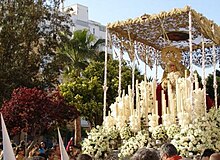
The territory now known as Andalusia fell within the sphere of influence of ancient Mediterranean
Bullfighting

While some trace the lineage of the Spanish Fighting Bull back to Roman times, today's fighting bulls in the Iberian peninsula and in the former Spanish Empire trace back to Andalusia in the 15th and 16th centuries.[206] Andalusia remains a center of bull-rearing and bullfighting: its 227 fincas de ganado where fighting bulls are raised cover 146,917 hectares (363,040 acres).[206] In the year 2000, Andalusia's roughly 100 bullrings hosted 1,139 corridas.[206]
The oldest bullring still in use in Spain is the neoclassical Plaza de toros in Ronda, built in 1784. The Andalusian Autonomous Government sponsors the Rutas de Andalucía taurina, a touristic route through the region centered on bullfighting.
Festivals
The Andalusian festivals provide a showcase for popular arts and traditional costume. Among the most famous of these are the Seville Fair or Feria de Abril in Seville, now echoed by smaller fairs in Madrid and Barcelona, both of which have many Andalusian immigrants; the Feria de Agosto in Málaga; the Feria de Jerez or Feria del Caballo in Jerez; the Feast of Corpus Christi in Granada; the Feria de Nuestra Señora de la Salud in Córdoba; the Columbian Festivals (Fiestas Colombinas) in Huelva; the Feria de la Virgen del Mar in Almería; and the Feria de San Lucas in Jaén, among many others.
Festivals of a religious nature are a deep Andalusian tradition and are met with great popular fervor. There are numerous major festivals during Holy Week. An annual pilgrimage brings a million visitors to the Hermitage of El Rocío in Almonte (population 16,914 in 2008); similarly large crowds visit the Santuario de Nuestra Señora de la Cabeza in Andújar every April.
Other important festivals are the
Andalusia hosts an annual festival for the dance of flamenco in the summer-time.
Cuisine

The Andalusian diet varies, especially between the coast and the interior, but in general is a Mediterranean diet based on olive oil, cereals, legumes, vegetables, fish, dried fruits and nuts, and meat; there is also a great tradition of drinking wine.[207]
The mountainous regions of the Sierra Morena and Sierra Nevada produce cured
Cereal-based dishes include migas de harina in eastern Andalusia (a similar dish to couscous rather than the fried breadcrumb based migas elsewhere in Spain) and a sweeter, more aromatic porridge called poleá in western Andalusia. Vegetables form the basis of such dishes as alboronía (similar to ratatouille) and the chopped salad known as pipirrana or piriñaca. Hot and cold soups based in olive oil, garlic, bread, tomato and peppers include gazpacho, salmorejo, porra antequerana, ajo caliente, sopa campera, or—using almonds instead of tomato—ajoblanco.[209]
Wine has a privileged place at the Andalusian table. Andalusian wines are known worldwide, especially
.Andalusia also produces D.O.
Other traditions
The traditional dress of 18th-century Andalusia was strongly influenced by
The
Andalusia has a great artisan tradition in
Andalusia is also known for its dogs, particularly the
Andalusian equestrianism, institutionalized in the Royal Andalusian School of Equestrian Art is known well beyond the borders of Spain. The Andalusian horse is strongly built, compact yet elegant, distinguished in the area of dressage and show jumping, and is also an excellent horse for driving. They are known for their elegant "dancing" gait.[214]
-
Tiles from the Alhambra.
-
Andalusian, in "Majo" dress
-
Sombreros cordobeses.
-
Sombrero de catite.
Sports
Team sports
In Andalusia, as throughout Spain,
For the 2023–24 season, five Andalusian clubs compete in Spain's First Division La Liga: Cádiz CF, Real Betis, Sevilla FC, Granada CF and UD Almería. Betis won La Liga in 1934–35 and Sevilla in the 1945–46 season.[216][217] The other Andalusian teams, Málaga CF, Recreativo de Huelva and Cordoba CF play in the Primera Federación, whilst Marbella FC, participates in the Segunda Federación, and Real Jaén participates in the Tercera División.
The
In recent decades,
Unlike basketball,
Andalusia's strongest showing in sports has been in table tennis. There are two professional teams: Cajasur Priego TM and Caja Granada TM, the latter being Spain's leading table tennis team, with more than 20 league championships in nearly consecutive years and 14 consecutive Copas del Rey, dominating the Liga ENEBÉ. Cajasur is also one of the league's leading teams.[219][citation needed]
Olympics
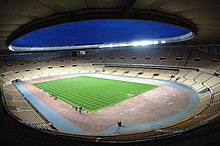
220 Andalusian athletes have competed in a total of 16 summer or winter Olympic Games. The first was Leopoldo Sainz de la Maza, part of the silver medal-winning polo team at the 1920 Summer Olympics in Antwerp, Belgium.[220]
In all, Andalusians have won six gold medals, 11 silver, and two bronze. Winners of multiple medals include the Córdoban boxer Rafael Lozano (bronze in the 1996 Summer Olympics at Atlanta, Georgia, US, and silver in the 2000 Summer Olympics in Sydney, Australia); sailor Theresa Zabell, Malagueña by adoption (gold medals at Barcelona in 1992 and Atlanta in 1996). Other notable winners have been Granadan tennis player Manuel Orantes (silver in the men's singles of the demonstration tournament in Mexico City in 1968), Jerezano riders Ignacio Rambla and Rafael Soto (silver in dressage in Athens in 2004) and the racewalker Paquillo Fernández from Guadix (silver in Athens in 2004).
The largest number of Olympic appearances were by the Malagueña swimmer
Seville has been a pre-candidate to host the Summer Olympics in two occasions, 2004 and 2008, and Granada has been a pre-candidate to host the winter Olympics; neither has ever succeeded in its candidature. The ski resort of Sierra Nevada, near Granada, has however hosted the 1996 Alpine World Ski Championships, and Granada hosted the 2015 Winter Universiade.
Other sports
Other sporting events in Andalusia include
Twinning and covenants
Andalusia has had a
See also
- Andalusian people
- Andalusian nationalism
- Azulejo
- List of Andalusians
- List of the oldest mosques
- Roman Bética Route
- San Juan De Los Terreros
- White Towns of Andalusia
- Yeseria
References
- ^ a b "Himno y escudo". Junta de Andalucia. Archived from the original on 15 October 2012.
- DRAE.
- ^ "Contabilidad Regional de España" (PDF). www.ine.es.
- ^ "Sub-national HDI - Area Database - Global Data Lab". hdi.globaldatalab.org. Archived from the original on 23 September 2018. Retrieved 24 June 2023.
- ^ "Andalusia". Collins English Dictionary. HarperCollins. Retrieved 8 March 2019.
- ^ "Andalusia"[dead link] (US) and "Andalusia". Lexico UK English Dictionary. Oxford University Press. Archived from the original on 22 March 2020.
- ^ "Andalusia". Merriam-Webster.com Dictionary. Retrieved 8 March 2019.
- ^ Boletín Oficial del Estado of Spain, n. 68 of 2007/03/20, p. 11872. Archived 9 June 2011 at the Wayback Machine Estatuto de Autonomía de Andalucía. Artículo 1: "Andalucía, como nacionalidad histórica y en el ejercicio del derecho de autogobierno que reconoce la Constitución, se constituye en Comunidad Autónoma en el marco de la unidad de la nación española y conforme al artículo 2 de la Constitución."
- ^ "Cuenca del Guadalquivir" (PDF). Archived (PDF) from the original on 3 January 2017. Retrieved 11 April 2013.
- ISBN 978-1-117-03148-4.
- ISBN 978-0-87099-636-8. Archivedfrom the original on 14 January 2024. Retrieved 25 September 2017.
- ISBN 90-04-14771-3. Archivedfrom the original on 14 January 2024. Retrieved 25 September 2017.
- ISBN 978-92-3-104153-2. Archivedfrom the original on 14 January 2024. Retrieved 7 April 2020.
- S2CID 13961320, archived from the original(PDF) on 29 July 2018, retrieved 7 December 2019
- ISBN 978-1-137-01347-7. Archived from the originalon 25 December 2019.
- ^ Francis Preston Venable (1894). A Short History of Chemistry. Heath. p. 21.
- from the original on 14 January 2024. Retrieved 14 October 2023.
- ^ "Climate and Average Weather Year Round in Córdoba (Spain)". Archived from the original on 14 January 2024. Retrieved 14 March 2023.
- ^ "Why the Guadalquivir valley is the pan of Spain (in Spanish)". 9 August 2018. Archived from the original on 14 January 2024. Retrieved 14 March 2023.
- ^ Kucheran, Kashlee (2 August 2019). "The 15 WARMEST Places to Visit in Europe This Winter". Travel Off Path. Archived from the original on 14 January 2024. Retrieved 6 September 2023.
- ^ "CartujaQanat – Recovering the Street Life in a Climate Changing World Journal 2: How is Sevilla moving the needle in the fight to urban climate transformation". 30 November 2021. Archived from the original on 30 November 2021. Retrieved 6 September 2023.
{{cite web}}: CS1 maint: bot: original URL status unknown (link) - ISBN 978-0-520-06697-7, archivedfrom the original on 14 January 2024, retrieved 16 October 2020
- ISBN 978-1-4437-4054-8, archived from the originalon 21 August 2014, retrieved 21 August 2014
- (PDF) from the original on 9 October 2022.
- ^ ISSN 1861-4302. Archived from the original (PDF) on 27 June 2008. Retrieved 8 September 2013.. It was the original name of the Punta Marroquí cape near Tarifa; very soon, it became generalized to designate the whole Peninsula. Undoubtedly, the name is of Pre-Indo-European origin. The parts of this compound (anda and luz) are frequent in the indigenous toponymy of the Iberian Peninsula.
Only a few years after the Islamic conquest of Spain, Al-Andalus appears in coin inscriptions as the Arabic equivalent of Hispania. The traditionally held view that the etymology of this name has to do with the Vandals is shown to have no serious foundation. The phonetic, morphosyntactic, and also historical problems connected with this etymology are too numerous. Moreover, the existence of this name in various parts of central and northern Spain proves that Al-Andalus cannot be derived from this Germanic tribe
- from the original on 14 January 2024. Retrieved 1 November 2017.
- S2CID 161971416.
- ^ ISBN 978-84-472-0485-4. Archivedfrom the original on 14 January 2024. Retrieved 14 November 2015.
- ^ a b Domínguez Ortiz, Antonio (1976). La identidad andaluza (in Spanish). Granada Puzada: Universidad de Granada.
- ^ Ladero Quesada, Miguel Ángel (1867). Sobre la génesis de la identidad andaluza. Andalucía entre Oriente y Occidente (1236–1492) (in Spanish). Córdoba (Diputación Provincial) Actas del V Coloquio de Historia Medieval de Andalucía.
- ^ For example, Pablo de Olavide was Intendente del Ejército de los cuatro reinos de Andalucía, "Intendant of the Army of the four kingdoms of Andalusia". Biografía Archived 1 January 2010 at the Wayback Machine, Fundación Pablo de Olavide. Retrieved 7 December 2009.
- ^ In Gelo del Cabildo's 1751 Respuestas generales, part of the write-up of the census Catastro of Ensenada, José María de Mendoza y Guzmán is described as visitador general of the Rentas Provinciales de los cuatro Reinos de Andalucía. See the digitization of the relevant document Archived 13 May 2007 at the Wayback Machine on the site of the Spanish Ministry of Culture. Enter "Gelo" in the search box "Buscador Localidades" and look at image number 3.
- ^ a b "Símbolos de Andalucía". Junta de Andalucía. Retrieved 9 August 2019.
- ^ ISBN 978-0-19-537610-4. Archivedfrom the original on 14 January 2024. Retrieved 11 December 2009.
- ISBN 978-84-609-2545-3. Archivedfrom the original on 14 January 2024. Retrieved 4 October 2020.
- ^ a b El Manifiesto andalucista de Córdoba describió a Andalucía como realidad nacional en 1919, cuyo espíritu los andaluces encauzaron plenamente a través del proceso de autogobierno recogido en nuestra Carta Magna. En 1978 los andaluces dieron un amplio respaldo al consenso constitucional. Hoy, la Constitución, en su artículo 2, reconoce a Andalucía como una nacionalidad en el marco de la unidad indisoluble de la nación española. Andalusian Statute of Autonomy on Wikisource, in Spanish.
- ISBN 978-1-74059-973-3. Archivedfrom the original on 14 January 2024. Retrieved 11 December 2009.
- ^ "Junta de Andalucía - Hija Predilecta o Hijo Predilecto de Andalucía". Junta de Andalucía (in Spanish). Retrieved 8 November 2020.
- ^ Domínguez Ortiz, Antonio (1976). La identidad andaluza (in Spanish). Granada: Universidad de Granada.
hay que buscar la esencia de Andalucía en su realidad geográfica, de una parte, y de otra, en la conciencia de sus habitantes. Desde el punto de vista geográfico, el conjunto de las tierras meridionales es demasiado amplio y variado para englobarlas a todas en una unidad. En realidad hay no dos, sino tres Andalucías: la Sierra Morena, el Valle y la Penibética
- ^ Rodriguez, Vicente (22 July 1998). "Gibraltar". Encyclopædia Britannica. Encyclopædia Britannica, Inc. Archived from the original on 14 January 2024. Retrieved 18 August 2009.
Gibraltar is an overseas territory of the United Kingdom and is self-governing in all matters but defence.
- ^ a b CMA de la Junta de Andalucía. "Climate of Andalusia". Iberia Nature. Archived from the original on 28 October 2009. Retrieved 10 December 2009.
- AEMET. Archivedfrom the original on 1 January 2021. Retrieved 24 March 2022.
- ^ "Climate of Andalusia". www.iberianature.com. Archived from the original on 28 October 2009. Retrieved 13 February 2017.
- ^ Junta de Andalucía. "Los tipos climáticos en Andalucía". Consejería del Medio Ambiente. Retrieved 10 December 2009.
- ISBN 84-344-3476-8.
- ISBN 84-344-3476-8.
- ^ "Ecosistemas naturales de Andalucía - Alta montaña". Junta de Andalucía (in Spanish). 2008. Archived from the original on 25 June 2009. Retrieved 2 February 2009.
- ^ "The type of climate in Andalusia". Consejería de Medio Ambiente (Junta de Andalucía). Archived from the original on 22 March 2018. Retrieved 4 October 2008.
- ^ a b AEMET (Agencia Estatal de Meteorología). "Valores extremos". Archived from the original on 6 October 2008. Retrieved 4 October 2008.
- ^ "300+ sunny days a year". Archived from the original on 28 July 2015. Retrieved 12 February 2021.
- ^ Meteorología, Agencia Estatal de. "Valores climatológicos normales - Agencia Estatal de Meteorología - AEMET. Gobierno de España". www.aemet.es (in Spanish). Retrieved 19 March 2024.
- ^ Junta de Andalucía. "Average temperature – Average water temperature – Hours of sunlight per year". Official Tourism Website of Andalucía. Archived from the original on 17 May 2016. Retrieved 10 December 2009.
- ^ aemetblog (2 August 2022). "14 de agosto de 2021,se batió el récord de temperatura más alta registrada en España". Aemetblog (in Spanish). Retrieved 19 March 2024.
- ^ "Standard Climate Values, Andalucía". Aemet.es. Retrieved 2 March 2015.
- ISBN 84-344-3476-8.
- ISBN 84-344-3476-8.
- ^ ISSN 0213-7585.
- ^ "Bases para la Ordenación del Territorio de Andalucía", 1990, p. 126, in Spanish.
- ISBN 84-344-3476-8.
- ^ "La nueva administración del agua en Andalucía". Agencia Andaluza del Agua (Consejería de Medio Ambiente). Archived from the original on 12 December 2008. Retrieved 4 October 2008.
- ISSN 1696-4284.
- ^ Consejería de Agricultura y Pesca (1992). "Suelos". Atlas Agrario y Pesquero de Andalucía (in Spanish). Junta de Andalucía.
- ^ Consejería de Medio Ambiente de Andalucía. "Tipología de los suelos en la comunidad andaluza" (PDF) (in Spanish). Archived (PDF) from the original on 9 October 2022. Retrieved 21 July 2008.
- ISSN 1696-4284.
- ISBN 84-344-3476-8.
- ^
Rubio, J.M. (2003). "La fauna andaluza". Geografía de Andalucía (Coor. López Antonio) (in Spanish). Barcelona: Ariel Geografía. ISBN 84-344-3476-8.
- ^ "Patrimonio vivo: la fauna andaluza". Consejería de Medio Ambiente (Junta de Andalucía). Archived from the original on 6 June 2009. Retrieved 4 October 2008.
- ^ Consejería de Medio Ambiente (Junta de Andalucía). "Espacios Protegidos". Retrieved 8 September 2008.[permanent dead link]
- ISBN 84-344-3476-8.
- ^ a b Consejería de Medio Ambiente (Junta de Andalucía). "La RENPA – Red de Espacios Naturales Protegidos de Andalucía". Retrieved 8 September 2008.[permanent dead link]
- ^ "La Primera Obra de Arte de la humanidad, ¿hecha por Neandertals?", abc.es, 7 February 2012, archived from the original on 26 August 2019, retrieved 31 December 2017
- ^ Pedro Espinosa (2006). "Hallado en Cádiz un muro de 3.000 años" [Found in Cádiz a wall of 3,000 years]. EL PAÍS. Cádiz. Archived from the original on 19 December 2011. Retrieved 2 January 2018.
- ^ Lapunzina, Alejandro (2005). Architecture of Spain. Greenwood Publishing Group. p. 81.
- ^ "Mezquita de Córdoba". archnet.org. Archived from the original on 4 March 2015. Retrieved 20 July 2021.
- ^ Lapunzina, Alejandro (2005). Architecture of Spain. Greenwood Publishing Group. p. 82.
- ISBN 0-521-66993-6.
- ISBN 953-6045-03-6. Archivedfrom the original on 6 April 2023. Retrieved 15 March 2021.
- ISBN 0-521-66993-6.
- ISBN 978-1-13905573-4.
- ISBN 978-1-4067-5027-0.
- ISBN 0-8018-6135-7.
- ^ It is even said that in 1641, the local nobility staged an alleged conspiracy in 1641 against the policies of Count-Duke of Olivares
- ISBN 978-0-8160-6935-4. Archivedfrom the original on 14 January 2024. Retrieved 14 November 2015.
- (PDF) from the original on 9 October 2022.
- ^ Charles J. Esdaile, Outpost of Empire: The Napoleonic Occupation of Andalucia, 1810–1812 (University of Oklahoma Press; 2013)
- ^ Preston, Paul. The Spanish Civil War. Reaction, revolution & revenge. Harper Perennial. 2006. London. pp. 105–107
- ^ Moreno Gómez, Francisco. 1936: el genocidio franquista en Córdoba. Editorial Crítica. Barcelona. 2008. p.12
- ^ Preston, Paul. The Spanish Civil War. Reaction, revolution & revenge. Harper Perennial. 2006. London. p.107
- Julián Casanova, Josep Maria Solé I Sabaté, Joan Villarroya and Francisco Moreno. Victimas de la guerra civil. Ediciones Temas de Hoy. 1999. Madrid. p.410
- ^ Antony Beevor, The Battle for Spain; The Spanish Civil War 1936–1939. Penguin Books. 2006. London. p.91
- ^ "El "holocausto de Málaga"". 18 August 2008. Archived from the original on 18 August 2016. Retrieved 8 May 2015.
- ^ La Opinión de Málaga. "San Rafael: la mayor fosa del país". Archived from the original on 8 December 2012. Retrieved 8 May 2015.
- ^ "Málaga, 1937". 4 October 2007. Archived from the original on 26 February 2021. Retrieved 8 May 2015.
- ^ "Málaga, historia de un siglo". Archived from the original on 24 February 2021. Retrieved 8 May 2015.
- ^ Hugh Thomas: Historia de la Guerra Civil Española; 1976; p. 636
- ^ Preston, Paul. The Spanish Civil War. Reaction, revolution & revenge. Harper Perennial. 2006. London. p.203
- ^ Junta de Andalucía. "Celebración del Referéndum de Autonomía del 28-F" (in Spanish). Archived from the original on 9 February 2007. Retrieved 12 August 2008.
- ^ Junta de Andalucía. "Asamblea de Parlamentarios para debatir el Estatuto de Autonomía". Archived from the original on 9 February 2007. Retrieved 12 August 2008.
...identidad histórica, en el autogobierno que la Constitución permite a toda nacionalidad, en plena igualdad al resto de nacionalidades y regiones que compongan España, y con un poder que emana de la Constitución y el pueblo andaluz, reflejado en su Estatuto de Autonomía
- ^ Estatuto de Autonomía Art. 118 Cap. III Tít. IV
- ^ Cabello, Alberto (23 October 2017). "El candidato a la alcaldía de Sevilla será quien más garantías nos dé". El Correo (in Spanish). Archived from the original on 22 August 2019. Retrieved 7 November 2017.
- Junta de Andalucía (in Spanish). Archivedfrom the original on 17 December 2008. Retrieved 8 October 2008.
- ^ "Parlamento de Andalucía. Funciones". Parliament of Andalusia (in Spanish). Archived from the original on 14 December 2009. Retrieved 8 October 2008.
- Junta de Andalucía (in Spanish). Archived from the originalon 8 April 2008. Retrieved 4 April 2019.
- ^ Junta de Andalucía. "Constitución del TSJA" (in Spanish). Archived from the original on 17 May 2016. Retrieved 8 October 2008.
- ^ a b c d Junta de Andalucía. Consejería de Gobernación. "Directorio de Entidades Locales" (in Spanish). Archived from the original on 23 December 2009. Retrieved 8 October 2008.
- ^ Tít. III. Art. 97. Comarcas – Estatuto de Autonomía de Andalucía 2007: :"1. La comarca se configura como la agrupación voluntaria de municipios limítrofes con características geográficas, económicas, sociales e históricas afines. 2. Por ley del Parlamento de Andalucía podrá regularse la creación de comarcas, que establecerá, también, sus competencias. Se requerirá en todo caso el acuerdo de los Ayuntamientos afectados y la aprobación del Consejo de Gobierno."
- ^ Mancomunidades Archived 1 July 2010 at the Wayback Machine (map), dgal.map.es. You can click the map to see the mancomunidades of each individual province.
- ^ "Ley 7/1993, de 27 de julio, reguladora de la demarcación municipal de Andalucía". Noticias Jurídicas. Retrieved 1 November 2014.
- ^ Inversion of the population pyramid is a process by which the number of older people exceeds the number of younger people. This often occurs in developed countries as birth rates decline.
- ^ "Datos del Registro de Entidades Locales". Ministerio de Asuntos Económicos y Transformación Digital. Retrieved 23 February 2024.
- ISBN 84-344-3476-8.
- ^ ISSN 0212-6621.
- ^ ISBN 84-344-3476-8.
- ^ ISSN 0210-5462.
- ^ Del Valle, C. (2005). "El envejecimiento demográfico en Andalucía y las características sociodemográficas de la población mayor de 64 años". Papers de Demografia (in Spanish) (255).
- Instituto Nacional de Estadística de España, 2005 census
- ^ "Población extranjera por Nacionalidad, comunidades, Sexo y Año". INE (in European Spanish). Archived from the original on 21 February 2022. Retrieved 14 July 2023.
- Joly Digital. 28 December 2007. p. 40. Retrieved 4 April 2019.
- ^ "Regional GDP per capita ranged from 30% to 263% of the EU average in 2018". Eurostat. Archived from the original on 9 October 2022.
- Junta de Andalucía. Archivedfrom the original on 23 February 2018. Retrieved 4 April 2019.
- ^ European Commission (2018). "Internal Market, Industry, Entrepreneurship and SMEs: Andalusia". Retrieved 10 July 2019.
- ^ IEA data for 2007
- ^ CIRCE and CEFIC Consultants and Bioeconomía en Andalucía (September 2016). "Andalusia as a model demonstrator region". Archived from the original on 26 July 2020. Retrieved 10 July 2019.
- ^ a b Consejería de Agricultura, Pesca y Desarrollo RuralSecretaría General de Agricultura y Alimentación (April 2015). "The Agricultural and Fisheries sector in Andalusia" (PDF). Archived (PDF) from the original on 9 October 2022. Retrieved 10 July 2019.
- ^ Consejería de Medio Ambiente. "Recursos de la agricultura: Recursos naturales de Andalucía" (PDF) (in Spanish). Retrieved 7 October 2008.
- ^ Junta de Andalucía, Impacto de la ayuda a la producción sobre el olivar andaluz Archived 19 April 2009 at the Wayback Machine, in El Olivar Andaluz Archived 12 December 2009 at the Wayback Machine, Besana. Retrieved 9 October 2008.
- ISBN 84-344-3476-8.
- ISBN 84-344-3476-8.
- ^ II PLAN ANDALUZ DE AGRICULTURA ECOLÓGICA (2007–2013) (PDF) (in Spanish). Empresa Pública Desarrollo Agrario y Pesquero, Consejería de Agricultura y Pesca, Junta de Andalucía. Archived from the original (PDF) on 24 August 2009. Retrieved 18 October 2008.
- ISBN 84-344-3476-8.
- ISBN 84-344-3476-8.
- ISBN 84-344-3476-8.
- ^ Consejería de Medio Ambiente. "Recursos forestales: Recursos naturales de Andalucía" (PDF) (in Spanish). Retrieved 7 October 2008.
- ^ "El Reino de España. Datos económicos generales – Abril 2007" (in Spanish). FAO (Food and Agriculture Organization of the United Nations). Archived from the original on 10 October 2008. Retrieved 5 October 2008.
- ISBN 84-344-3476-8.
- ^ "Peligra la supervivencia de algunas plantas marinas en el litoral malagueño" (in Spanish). 15 May 2002. Archived from the original on 3 December 2008. Retrieved 18 October 2008.
- ^ Consejería de Medio Ambiente. "Recursos del mar: Recursos naturales de Andalucía" (PDF) (in Spanish). Retrieved 7 October 2008.
- ^ Consejería de Medio Ambiente. "Energía y minerales: Recursos naturales de Andalucía" (PDF) (in Spanish). Retrieved 7 October 2008.
- ^ IEA: Contabilidad Regional de Andalucía[full citation needed]
- ISBN 84-344-3476-8.
- ^ a b Genaro, M.D.; González, F.J. (1997). "La terciarización en Andalucía: evolución de la producción y el empleo" (PDF). Actas del I Congreso de Ciencia Regional de Andalucía: Andalucía en el umbral del siglo XX (in Spanish). Archived from the original (PDF) on 31 March 2010. Retrieved 12 December 2009.
- ISBN 84-7231-613-0.
- ISBN 84-344-3476-8.
- ^ "Banderas negras 2008 en Andalucía" (in Spanish). Archived from the original on 26 July 2011. Retrieved 18 October 2008.
- ^ "Destrucción a toda costa" (PDF) (in Spanish). 2 February 2007. Archived (PDF) from the original on 9 October 2022. Retrieved 19 October 2008.
- ^ "Responsible Tourism in FITUR, Spain – European Network for Accessible Tourism".
- ^ Padilla, Brenda (18 October 2013). "Environmentally Sustainable Tourism in Andalucia". Andalucia.com.
- ^ Fuerte Hoteles, Devotedly Focused on Responsible Tourism – Sustainable Tourism World Archived 28 October 2015 at the Wayback Machine
- ^ Decreto 553/1967, de 2 de marzo, por el que se declara conjunto histórico artístico el sector denominado "Lugares Colombinos" en la provincia de Huelva. He was laid to rest in Seville Cathedral. BOE nº 69 de 22 March 1967. Archived 27 September 2007 at the Wayback Machine
- ^ "Pablo Picasso, Andalucia | Southern Spain". www.andalucia.com. 12 February 2014. Retrieved 4 December 2017.
- ^ "Regional Unemployment by NUTS2 Region". Eurostat. Archived from the original on 5 November 2018. Retrieved 13 November 2018.
- ^ ISBN 84-344-3476-8.
- ^ Cañavate, Jose Luis; Corral, Carlos (2004). La bicicleta como medio de transporte en Andalucía (in Spanish). Consejería de Medio Ambiente de la Junta de Andalucía.
- ^ Productos Alta Velocidad Archived 8 December 2009 at the Wayback Machine, RENFE/AVE. Retrieved 11 December 2009.
- ^ a b "Informes sobre la utilización de los aeropuertos de España en los últimos años" (in Spanish). AENA. Archived from the original on 8 January 2008. Retrieved 17 January 2008.
- ^ "My Home in Andalucia | Home". My Home in Andalucia | Home. Retrieved 31 October 2017.
- ISBN 978-84-96776-06-7.
- ^ "Andalucía. El Plan de Infraestructuras para el transporte sostenible prevé una inversión de 30.000 millones". Ecoticias.com (in Spanish). 16 September 2008. Archived from the original on 19 September 2008. Retrieved 11 December 2009.
- ^ Abengoa opens the first EU commercial concentrating Solar Power Tower Archived 9 June 2009 at the Wayback Machine, RenewableEnergyMagazine.com, 2 April 2007.
- ^ La central solar de alta temperatura de Andasol 2 ya ha puesto la primera piedra Archived 28 September 2007 at the Wayback Machine, Energías Renovables, 12 July 2007.
- ^ Plataforma Solar de Almeria Archived 26 September 2011 at the Wayback Machine, Institute of Technical Thermodynamics, German Aerospace Center. Retrieved 11 December 2009.
- ^ Sancho, Elio (4 July 2019). "Medgaz une dos continentes con la obra firmada por García Lorca". Diario de Almería.
- ^ www.andaluciainvestiga.com Archived 24 February 2013 at the Wayback Machine
- ^ Plan Andaluz de Investigación, Desarrollo e Innovación. PAIDI. 1 May 2005.
- ^ Andalucía Comunidad Cultural. "Medios de comunicación en Red Andaluza". Archived from the original on 15 October 2008. Retrieved 8 October 2008. That web page gives a rather complete listing of Andalusian media organizations.
- ISSN 0034-8155.
- ISSN 0214-7564.
- ^ José Ortega y Gasset, Teoría de Andalucía Archived 19 May 2011 at the Wayback Machine, 1927, online at Wikisource in Spanish.
- ISSN 1695-7229.
- ISBN 9780300218701. Archivedfrom the original on 14 January 2024. Retrieved 27 June 2023.
- ISSN 0214-7564.
- ISSN 1576-5628.
- ISBN 978-84-8266-725-6.
- ISBN 84-8095-305-5.
- ISBN 84-86944-04-X.
- ISSN 1130-5762.
- ^ "Iconic Cultural Image Heads Selection of Works by Top Spanish Artists" (PDF). Sotheby's. Archived (PDF) from the original on 4 March 2016. Retrieved 29 July 2016.
- ISSN 0004-0428.
- ^ "El costumbrismo en la pintura sevillana del siglo XIX" (PDF). Cervantesvirtual.com. Archived (PDF) from the original on 16 September 2008. Retrieved 9 October 2008.
- ISSN 0211-3589.
- ISBN 0-521-66993-6.
- ^ Hernández, A. (2004). "Las dos vertientes del barroco español". Correo del Maestro (in Spanish). 8 (92). Archived from the original on 21 December 2009.
- ISSN 0011-250X.
- ISSN 0213-7305. Archived from the original(PDF) on 6 October 2007.
- ^ From Article 37.1.18 of the Andalusian Statute of Autonomy: Principios rectores de las políticas públicas: 18º La conservación y puesta en valor del patrimonio cultural, histórico y artístico de Andalucía, especialmente del flamenco.
- ^ From Article 68 of the Andalusian Statute of Autonomy: Corresponde asimismo a la Comunidad Autónoma (Andaluza) la competencia exclusiva en materia de conocimiento, conservación, investigación, formación, promoción y difusión del flamenco como elemento singular del patrimonio cultural andaluz.
- ISBN 9780241217481. Archivedfrom the original on 14 January 2024. Retrieved 30 October 2019.
- ^ Ferca Network. "Camarón de la Isla" (in Spanish). Zerobox. Archived from the original on 23 November 2008. Retrieved 10 June 2008.
- ^ Antonio Burgos (1998). "Los del Río, o cómo hacerse perdonar el éxito". S.L. Sevilla, España (in Spanish). Arco del Postigo. Archived from the original on 22 May 2008. Retrieved 10 May 2008.
- ^ "Rosa López volverá a representarnos en Eurovisión". FórmulaTV.com (in Spanish). 29 June 2008. Archived from the original on 2 July 2008. Retrieved 10 June 2008.
- ^ "David Bisbal recibe 5 discos de platino en España y un disco de oro en USA y Puerto Rico". Vale Music (in Spanish). 2008. Archived from the original on 28 October 2007. Retrieved 10 June 2008.
- Associated Press News. 22 February 2023. Archivedfrom the original on 23 February 2023. Retrieved 23 February 2023.
- ^ Andalucía alcanza los 1.000 rodajes gestionados por la Red de Ciudades de Cine de AFC[permanent dead link], 2008-07-30, www.andaluciafilm.com. Retrieved 16 December 2009.
- ^ El Rocio Pilgrimage Archived 31 October 2015 at the Wayback Machine, visithuelva.com. Retrieved 15 April 2010.
- ^ hermandadrociosevilla.com Archived 24 July 2012 at the Wayback Machine, passim. Retrieved 14 April 2010.
- ^ Eva Díaz Pérez, "Los excesos del Rocío" Archived 26 February 2021 at the Wayback Machine, El Mundo, 27 May 2001. Retrieved 14 April 2010.
- ISBN 0-313-29224-8.
- ISSN 0034-7981.
- ISSN 1571-4667. Archived from the original(PDF) on 24 December 2009. Retrieved 16 December 2009.
- ^ For some maps of various isoglosses, see the online Isogloss maps for Iberian Peninsula Spanish, according to ALPI Archived 28 September 2011 at the Wayback Machine.
- ^ "La extrema izquierda andaluza reivindica el 'andalûh' en el Senado". Libertad Digital (in Spanish). 27 September 2021.
- ^ "Interactivo: Creencias y prácticas religiosas en España". 2 April 2015. Archived from the original on 4 April 2015. Retrieved 25 January 2017.
- ISBN 9781474291781.
- Real Academia Española.
- ^ a b c Cepeda Carrión, Gabriel; del Milagro Martín López, María. "Las plazas de toros de Andalucía y su incidencia turística" (in Spanish). p. 14. Retrieved 6 October 2008.
- ISBN 84-922831-9-X.
- ^ Resolución del 20 de junio de 1988 de la Dirección General de Pesca, por la que se establece una pesca indefinida para la pesca del Aphia minuta (chanquete) y similares (BOJA nº57 de 19 de julio de 1988).
- ISSN 1133-6293.
- ISBN 84-472-0210-0.
- ISBN 84-472-0210-0.
- ^ a b For greater specificity on the denominaciones de origen, see M.A.P.A. Archived 6 March 2011 at the Wayback Machine, in Spanish.
- ISSN 0212-8594.
- ^ Real Escuela Andaluza de Arte Ecuestre Archived 15 December 2009 at the Wayback Machine, official site.
- ^ "Año fundación del Recreativo de Huelva" (in Spanish). Liga de Fútbol Profesional (España). Archived from the original on 18 April 2008. Retrieved 7 October 2008.
- ^ "Palmarés" (in Spanish). Liga de Fútbol Profesional. Archived from the original on 30 July 2008.
- ^ 2006: Sevilla win big in Monaco Archived 8 January 2010 at the Wayback Machine, 25 August 2006, UEFA.com. Retrieved 17 December 2009.
- ISBN 84-689-6145-0.
- ^ LIGAS NACIONALES / Liga "Arteal Ventanas" Superdivisión Masculina, Real Federación Española de Tenis de Mesa. Retrieved 2009-12-17 cites for the current prominent status of these teams.
- ISBN 978-0-7864-9577-1.
- ^ "Andalucía en los Juegos Olímpicos". Fundación Andalucía Olímpica (in Spanish). Archived from the original on 10 June 2008. Retrieved 8 October 2008.
- ^ "Hermanamientos de la Ciudad Autónoma de Buenos Aires" (PDF). official site of Buenos Aires (in Spanish). Archived from the original (PDF) on 6 July 2011. Retrieved 4 April 2019.
External links
- . Encyclopædia Britannica. Vol. II (9th ed.). 1878. pp. 10–11.
- Official site – Junta de Andalucia
- Andalucia Tourism Site
- Andalucia page at the guardian











